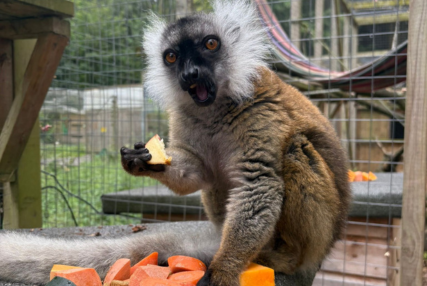 Hoo Zoo and Dinosaur World in Telford have welcomed a female Black Lemur, after the animal travelled 220 miles to her new home as part of a European breeding programme.
Hoo Zoo and Dinosaur World in Telford have welcomed a female Black Lemur, after the animal travelled 220 miles to her new home as part of a European breeding programme.
Vahlia, the Black Lemur, who is two years old, has travelled an impressive 220 miles from Howletts Wild Animal Park in Kent to join male Black Lemur, Bomani, at her new home in Shropshire. Her arrival marks an important step in the coordinated international efforts to conserve this endangered species.
Black Lemurs, native to Madagascar, are currently classified as "Endangered" by the International Union for Conservation of Nature (IUCN). Wild populations continue to decline due to deforestation, hunting, and the pet trade. Although her new companion, Bomani, is unable to breed, it is hoped that Vahlia will be able to breed as part of the European Endangered Species Programme in future. The European Endangered Species Programme is a Europe wide initiative contributing to the long-term survival of various animal species.
Guests at the zoo will now be able to see Vahlia and Bomani in the Madagascar area, where they will serve as ambassadors for their species, helping to raise awareness of the threats faced by Madagascar’s unique wildlife. Hoo Zoo and Dinosaur World is already home to a wide range of other endangered lemur species including Ring Tailed Lemurs, Black and White Ruffed Lemurs and Mouse Lemurs.
“We are thrilled to welcome Vahlia to Hoo Zoo and Dinosaur World. Her journey from Howletts is part of a much bigger story, the vital international effort to save the Black Lemur from extinction. She has settled in really well and has already formed a strong bond with Bomani,” said Hoo Zoo and Dinosaur World Owner, Will Dorrell.
“Guests to the zoo might be surprised to see that Vahlia is a tawny brown colour despite being a black lemur, this is because the species are sexually dimorphic with males appearing black and females being a tawny brown. Her overall role at the zoo is part of a much bigger picture, also helping our visitors understand the importance of protecting Madagascar’s extraordinary and unique wildlife."
Related
Comments
Comments are disabled for this post.




 to add an item to your Itinerary basket.
to add an item to your Itinerary basket.






